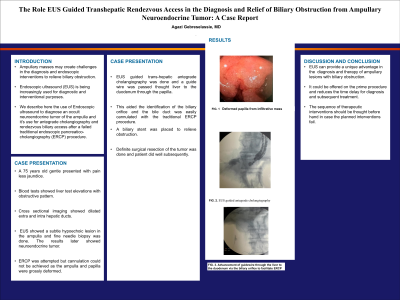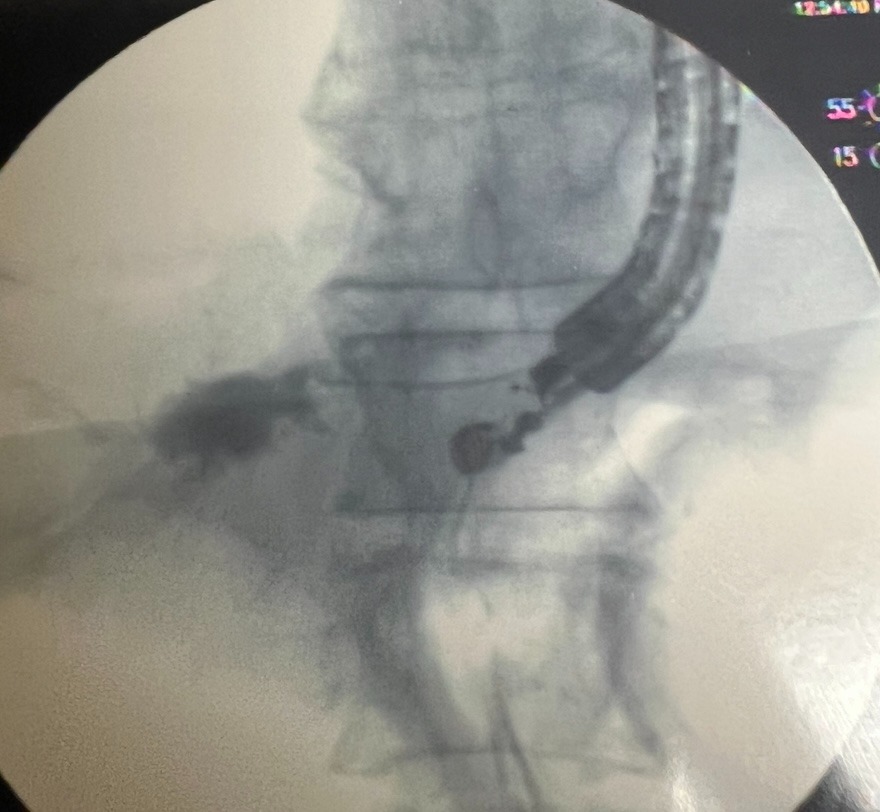Sunday Poster Session
Category: Interventional Endoscopy
P0868 - The Role EUS Guided Transhepatic Rendezvous Access in the Diagnosis and Relief of Biliary Obstruction from Ampullary Neuroendocrine Tumor: A Case Report
Sunday, October 22, 2023
3:30 PM - 7:00 PM PT
Location: Exhibit Hall

Has Audio

Agazi Gebreselassie, MD, MSc
University of Maryland/BWMC/Woodholme GI
Glen, MD
Presenting Author(s)
Agazi Gebreselassie, MD, MSc
University of Maryland/BWMC/Woodholme GI, Glen, MD
Introduction: Ampullary neuroendocrine tumors are rare causes of biliary obstruction. They may present a diagnostic and therapeutic challenge. Here we describe the multi-layer role of endoscopic ultrasound (EUS) in the diagnosis and assisting treatment in a patient who presented with obstructive jaundice when cross sectional imaging failed to indicate cause of obstruction.
Case Description/Methods: A 77 years old male presented with obstructive jaundice. He underwent imaging studies, including magnetic resonance cholangiopancreatography (MRCP) which showed dilation of intra and extrahepatic bile ducts. He subsequently underwent EUS examination which confirmed dilated intra and extrahepatic bile ducts. There was a 5 mm hypoechoic lesion in the ampulla which was not amenable to EUS guided fine needle biopsy. Endoscopic retrograde cholangiopancreatography (ERCP) was not possible due to ampullary deformity. The echoendoscope was used to access intrahepatic duct in segment two using a 19 gauge needle. A 0.025 inch long guidewire was advanced through the liver to the ampulla and duodenum. The needle was removed and the echoendoscope was withdrawn slowly leaving the guidewire in place. Then the duodenoscope was advanced to the second part of the duodenum and the bile duct was cannulated easily with a sphincterotome over a guidewire side to side to the previously placed guidewire. The previously placed guidewire was pulled out through the mouth. Sphincterotomy was done which revealed unremarkable ampullary mucosa. Ampullary biopsy and distal common bile duct brushing were done. A plastic stent was placed to relieve obstruction. Biopsy results showed high grade neuroendocrine tumor. (NET). The patient subsequently underwent Whipple's procedure with curative intent. Surgical pathology showed a NET extending to the bile ducts. The patient did very well after surgery and during subsequent follow ups.
Discussion: EUS can assist in the diagnosis obscure causes of bile duct obstruction and can aid to relieve obstruction. Small neuroendocrine tumors can cause biliary obstruction and may not be identified on cross sectional imaging including MRI. EUS can identify these lesions and fine needle biopsies can be done. Retrograde biliary cannulation might be challenging in such conditions because of deformity of the ampulla. EUS can assist in guiding access to the bile duct and avoid unnecessary need for percutaneous approaches, hence improving patients' quality of life until definitive treatment is provided.

Disclosures:
Agazi Gebreselassie, MD, MSc. P0868 - The Role EUS Guided Transhepatic Rendezvous Access in the Diagnosis and Relief of Biliary Obstruction from Ampullary Neuroendocrine Tumor: A Case Report, ACG 2023 Annual Scientific Meeting Abstracts. Vancouver, BC, Canada: American College of Gastroenterology.
University of Maryland/BWMC/Woodholme GI, Glen, MD
Introduction: Ampullary neuroendocrine tumors are rare causes of biliary obstruction. They may present a diagnostic and therapeutic challenge. Here we describe the multi-layer role of endoscopic ultrasound (EUS) in the diagnosis and assisting treatment in a patient who presented with obstructive jaundice when cross sectional imaging failed to indicate cause of obstruction.
Case Description/Methods: A 77 years old male presented with obstructive jaundice. He underwent imaging studies, including magnetic resonance cholangiopancreatography (MRCP) which showed dilation of intra and extrahepatic bile ducts. He subsequently underwent EUS examination which confirmed dilated intra and extrahepatic bile ducts. There was a 5 mm hypoechoic lesion in the ampulla which was not amenable to EUS guided fine needle biopsy. Endoscopic retrograde cholangiopancreatography (ERCP) was not possible due to ampullary deformity. The echoendoscope was used to access intrahepatic duct in segment two using a 19 gauge needle. A 0.025 inch long guidewire was advanced through the liver to the ampulla and duodenum. The needle was removed and the echoendoscope was withdrawn slowly leaving the guidewire in place. Then the duodenoscope was advanced to the second part of the duodenum and the bile duct was cannulated easily with a sphincterotome over a guidewire side to side to the previously placed guidewire. The previously placed guidewire was pulled out through the mouth. Sphincterotomy was done which revealed unremarkable ampullary mucosa. Ampullary biopsy and distal common bile duct brushing were done. A plastic stent was placed to relieve obstruction. Biopsy results showed high grade neuroendocrine tumor. (NET). The patient subsequently underwent Whipple's procedure with curative intent. Surgical pathology showed a NET extending to the bile ducts. The patient did very well after surgery and during subsequent follow ups.
Discussion: EUS can assist in the diagnosis obscure causes of bile duct obstruction and can aid to relieve obstruction. Small neuroendocrine tumors can cause biliary obstruction and may not be identified on cross sectional imaging including MRI. EUS can identify these lesions and fine needle biopsies can be done. Retrograde biliary cannulation might be challenging in such conditions because of deformity of the ampulla. EUS can assist in guiding access to the bile duct and avoid unnecessary need for percutaneous approaches, hence improving patients' quality of life until definitive treatment is provided.

Figure: Transhepatic EUS guided biliary access and cholagiography
Disclosures:
Agazi Gebreselassie indicated no relevant financial relationships.
Agazi Gebreselassie, MD, MSc. P0868 - The Role EUS Guided Transhepatic Rendezvous Access in the Diagnosis and Relief of Biliary Obstruction from Ampullary Neuroendocrine Tumor: A Case Report, ACG 2023 Annual Scientific Meeting Abstracts. Vancouver, BC, Canada: American College of Gastroenterology.
